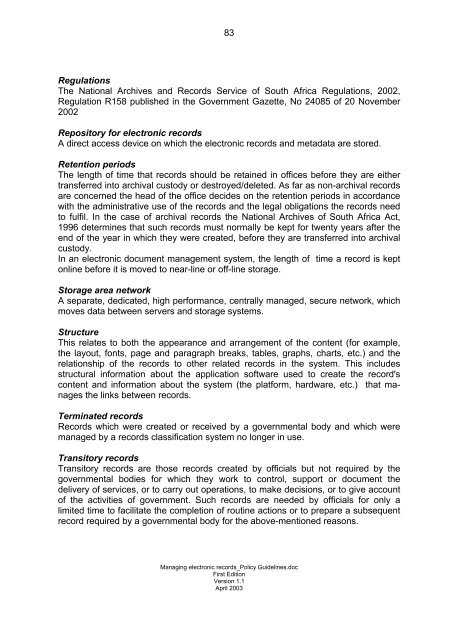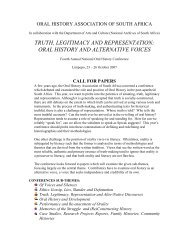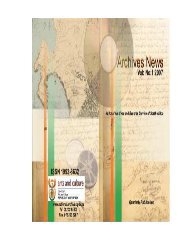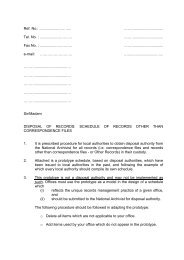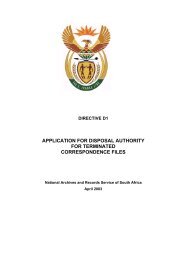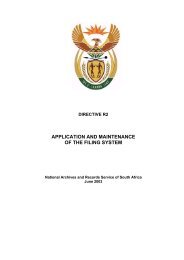managing electronic records in governmental bodies - National ...
managing electronic records in governmental bodies - National ...
managing electronic records in governmental bodies - National ...
You also want an ePaper? Increase the reach of your titles
YUMPU automatically turns print PDFs into web optimized ePapers that Google loves.
83<br />
Regulations<br />
The <strong>National</strong> Archives and Records Service of South Africa Regulations, 2002,<br />
Regulation R158 published <strong>in</strong> the Government Gazette, No 24085 of 20 November<br />
2002<br />
Repository for <strong>electronic</strong> <strong>records</strong><br />
A direct access device on which the <strong>electronic</strong> <strong>records</strong> and metadata are stored.<br />
Retention periods<br />
The length of time that <strong>records</strong> should be reta<strong>in</strong>ed <strong>in</strong> offices before they are either<br />
transferred <strong>in</strong>to archival custody or destroyed/deleted. As far as non-archival <strong>records</strong><br />
are concerned the head of the office decides on the retention periods <strong>in</strong> accordance<br />
with the adm<strong>in</strong>istrative use of the <strong>records</strong> and the legal obligations the <strong>records</strong> need<br />
to fulfil. In the case of archival <strong>records</strong> the <strong>National</strong> Archives of South Africa Act,<br />
1996 determ<strong>in</strong>es that such <strong>records</strong> must normally be kept for twenty years after the<br />
end of the year <strong>in</strong> which they were created, before they are transferred <strong>in</strong>to archival<br />
custody.<br />
In an <strong>electronic</strong> document management system, the length of time a record is kept<br />
onl<strong>in</strong>e before it is moved to near-l<strong>in</strong>e or off-l<strong>in</strong>e storage.<br />
Storage area network<br />
A separate, dedicated, high performance, centrally managed, secure network, which<br />
moves data between servers and storage systems.<br />
Structure<br />
This relates to both the appearance and arrangement of the content (for example,<br />
the layout, fonts, page and paragraph breaks, tables, graphs, charts, etc.) and the<br />
relationship of the <strong>records</strong> to other related <strong>records</strong> <strong>in</strong> the system. This <strong>in</strong>cludes<br />
structural <strong>in</strong>formation about the application software used to create the record's<br />
content and <strong>in</strong>formation about the system (the platform, hardware, etc.) that manages<br />
the l<strong>in</strong>ks between <strong>records</strong>.<br />
Term<strong>in</strong>ated <strong>records</strong><br />
Records which were created or received by a <strong>governmental</strong> body and which were<br />
managed by a <strong>records</strong> classification system no longer <strong>in</strong> use.<br />
Transitory <strong>records</strong><br />
Transitory <strong>records</strong> are those <strong>records</strong> created by officials but not required by the<br />
<strong>governmental</strong> <strong>bodies</strong> for which they work to control, support or document the<br />
delivery of services, or to carry out operations, to make decisions, or to give account<br />
of the activities of government. Such <strong>records</strong> are needed by officials for only a<br />
limited time to facilitate the completion of rout<strong>in</strong>e actions or to prepare a subsequent<br />
record required by a <strong>governmental</strong> body for the above-mentioned reasons.<br />
Manag<strong>in</strong>g <strong>electronic</strong> <strong>records</strong>_Policy Guidel<strong>in</strong>es.doc<br />
First Edition<br />
Version 1.1<br />
April 2003


